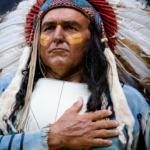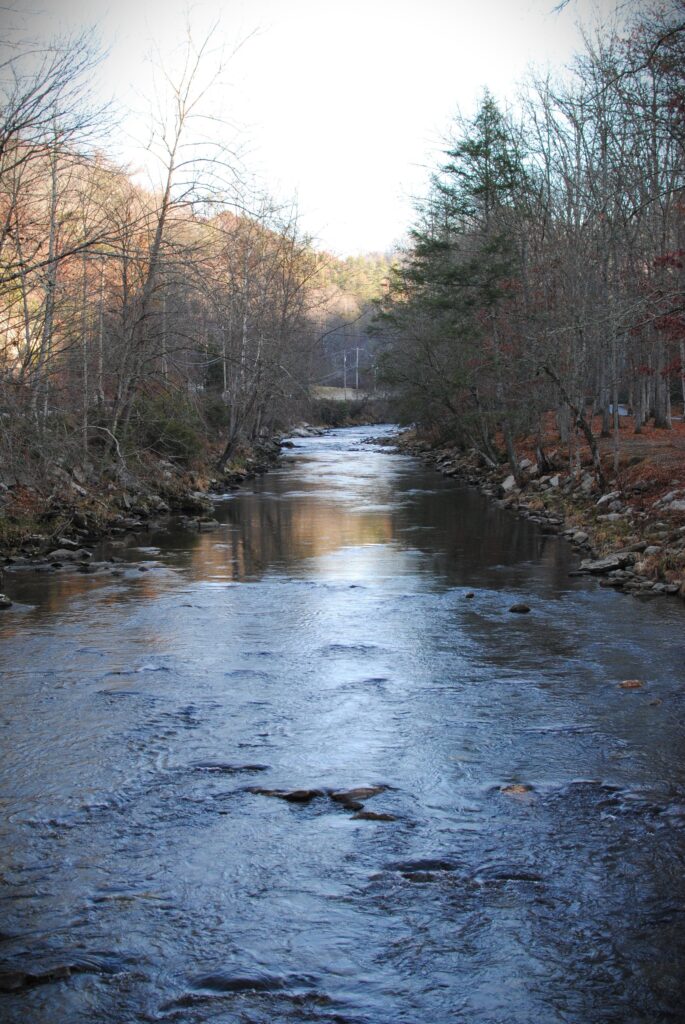 Dave and I spent Thanksgiving weekend in the North Carolina mountains. First, we rode a steam train along the Tuckasegee River. On Saturday, we hiked up to Mingo Falls and then took a leisurely three-mile stroll along the Oconaluftee River in Cherokee. It seemed appropriate to wind up Native American Heritage Month in a native town. As someone who loves being on, in, or near water, I felt incredibly close to the people who lived along this river. The Cherokee recognized the spiritual importance of bodies of water and believed they were imbued with special powers. I was once jokingly described as part fish, so I appreciate their sentiments and love of the water.
Dave and I spent Thanksgiving weekend in the North Carolina mountains. First, we rode a steam train along the Tuckasegee River. On Saturday, we hiked up to Mingo Falls and then took a leisurely three-mile stroll along the Oconaluftee River in Cherokee. It seemed appropriate to wind up Native American Heritage Month in a native town. As someone who loves being on, in, or near water, I felt incredibly close to the people who lived along this river. The Cherokee recognized the spiritual importance of bodies of water and believed they were imbued with special powers. I was once jokingly described as part fish, so I appreciate their sentiments and love of the water.
Ancient people understood the cycle of water and its connections to the cycle of life. Springs bubble up out of the ground high in the Smoky Mountains. Rain falls as the water tumbles down the ancient, craggy slopes, creating streams that grow into rivers. As these flow toward the sea, they give life to plants, animals, and people. Without this, there would be no life. The rivers grow larger and eventually meet the sea where the clouds gather the water and carry it to form rain above the mountains. The cycle continues.
The Cherokee saw the river as Gunahita asgaya, the Long Man, whose head was in the mountains and his feet in the sea. His body stretched over the distance between. The Long Man was called upon for strength, cleansing, and to wash away sadness or sickness. Many prayers and rituals involve streams, rivers, or ponds. “Going to Water” was one of these sacred rituals.
The Cherokee would go down to the water early in the morning every morning, wade out waist deep, take the water of the river and throw it up over his head, and say, “Wash away any thoughts or feelings that may hinder me from being closer to my god. Take away any thoughts or feelings that may hinder me from being closer to all my brothers and sisters on the earth, and the animals of the earth.” And they would wash themselves and cleanse themselves every morning. And they would walk out of the water. – from Living Stories of the Cherokee
But who were these water-loving people?

In his book Myths of the Cherokee, Walter Mooney relates the stories he learned while chatting with the elders in their village in the late 19th century. According to their folklore, the origin of the earth is “a great island floating in a sea of water, and suspended at each of the four cardinal points by a cord hanging down from the sky vault… When the world grows old and worn out, the people will die, and the cords will break and let the earth sink down into the ocean, and all will be water again.” They believed humans begin in water and will return to water.
While that is a thought-provoking concept, there are two more likely versions of their origins, and one is the reverse of the other. Walter Mooney also noted the oral tradition that the Cherokee, one of the tribes of the Iroquoian language group, migrated south from the Great Lakes in prehistoric times and landed in the area along the Tennessee River. They then spread throughout western North Carolina, Tennessee, South Carolina, and Georgia. On the other hand, Thomas Whyte writes that the proto-Iroquoian people developed in Appalachia and broke off from the primary group. They moved northward into New York, Michigan, and Canada. Linguistically, the former is more likely as analysis shows distinct differences between the Cherokee and the northern Iroquois tribes. Whichever way it happened, scholars are divided on when this split occurred, but most agree the migration occurred between 1800 and 1500 BCE.
 Once they arrived in the area, they built substantial mounds with tribal centers on top. Smaller villages clustered around the base. From the window on our train, we could see one of them. The guide told us it was initially thirty meters tall, but today, it has eroded to roughly five meters. These complexes of earthenwork platforms and villages dot the landscape along the major rivers, such as the Tuckasegee, upper Little Tennessee, Hiwasee, French Broad, and others. Around 200 BC, they built what is now known as the Biltmore Mound, which was found on the Swannanoa River in 1984. Numerous Native sites have been discovered on the grounds of the estate.
Once they arrived in the area, they built substantial mounds with tribal centers on top. Smaller villages clustered around the base. From the window on our train, we could see one of them. The guide told us it was initially thirty meters tall, but today, it has eroded to roughly five meters. These complexes of earthenwork platforms and villages dot the landscape along the major rivers, such as the Tuckasegee, upper Little Tennessee, Hiwasee, French Broad, and others. Around 200 BC, they built what is now known as the Biltmore Mound, which was found on the Swannanoa River in 1984. Numerous Native sites have been discovered on the grounds of the estate.
During the late Archaic and Woodland Periods, they cultivated plants such as marsh elder, lambs quarters, pigweed, sunflowers, and squash to supplement the fish and game they hunted. Between 1000 and 1500, women crossbred new varieties of maize or corn, similar to the ears we recognize today. This plant produced much higher yields and allowed the rise of larger chiefdoms with more villages. Festivals, such as the Green Corn Ceremony, became popular annual events.
Much of what we know prior to the early 18th century comes from Spanish explorers. In 1540, Hernando de Soto led an expedition into the ancestral lands of the Cherokee, Muscogee, Cheraw, and Catawba. In 1566, Juan Pardo traveled from South Carolina to western North Carolina and eastern Tennessee. He recorded meeting Cherokee people while he stayed at the Joara chiefdom. These early accounts describe distinctive cultural differences.
Polygamy was common throughout the tribes, especially among the elite men. However, they followed a matrilinear culture. The women controlled the property, land, and dwellings. The children were born into the mother’s clan, attaining its hereditary status. A council of women elders had to approve any advancement into leadership roles. A married couple lived with or near the woman’s family so that she could receive support from her female family members. The woman’s elder brother mentored her sons, being considered a closer relation since the father belonged to another clan. Divorce was common and could be freely practiced by the women. While it was not uncommon later for a Native woman to take a European husband, Native men rarely married outside of the tribe as the children of such a union would not be recognized as they were born outside the tribe. As you can imagine, this was a new concept for these Spanish explorers.
Cherokee women were honored as the “givers of life” and held rights as heads of households. They owned the land, made the decisions, and led the community. Redefining these roles did not occur until well into the late 18th century. After the Revolutionary War, the Europeans began to push their social standards, rules, and norms on the Native people. However, this movement toward a male-dominated society was slow to arrive. Historians agree that “white agents” were behind the shift of attitude toward women’s roles. These “white agents” are assumed to be the European missionaries and white settlers seeking manifest destiny, or the idea that white Americans were divinely ordained to settle the entire continent of North America.
The situation declined over the following years. When British soldiers built forts in the Cherokee lands during the French & Indian War, serious misunderstandings between the two allies resulted in the Anglo-Cherokee War in 1760.
In 1765, Henry Timberlake took three Cherokee chiefs to London to meet King George III, hoping to strengthen their peaceful relationship. Several news reports described them as “of middle stature, of an olive colour, tho’ generally painted and their skins stained with gun-powder, into it in very pretty figures. The hair of their head is shaved.”
King George III issued a Royal Proclamation in 1763 forbidding British settlement on Cherokee lands. It was an attempt by the government to maintain peaceful relations with the tribes they depended on as allies. However, preventing colonists from encroaching on these lands proved challenging to enforce. Pushing ever further, Daniel Boone led a party into Kentucky in 1771-1772, which ended in a skirmish in which many were killed on either side, including Boone’s son, James.
Tensions flared back and forth, with Chief Dragging Canoe attacking settlers and the North Carolina militia retaliating in 1776, burning more than 50 Cherokee towns. Dragging Canoe settled along Chickamauga Creek in what is now Chattanooga, Tennessee, and set up a network of villages. From here, he fought guerilla-style wars against encroachment from 1776 to 1794. The first Treaty of Tellico Blockhouse, 7 November 1794, brought peace to the area between the Cherokee and the newly independent Americans.
The traders and government agents dealing with the Natives were more often than not Scottish or of Scottish descent, and nearly all of those were documented as being from the Highlands. Many of these men married local women and remained with them long after the fighting ended. Numerous mixed-race children grew up in the Native culture and became important leaders among the Five Civilized Tribes of the South East.
Relations with the settlers were tenuous at best, with flare-ups occurring off and on between them. This tenuous peace ended in 1828 when gold was found on tribal lands in Dahlonega, Georgia. Americans had been pressuring the federal government to make more land available to settlers and remove the Indians. While this effort was opposed by a few, including Davy Crockett of Tennessee, President Andrew Jackson eventually gained Congressional approval of the Indian Removal Act of 1830. This Act authorized the government to extinguish any Indian title to land in the Southeast.
In 1831, the Choctaw became the first Nation to be removed. This plan served as the model for the rest. Between 1830 and 1850, more than 60,000 members of the Five Civilized Tribes were forcibly removed from their land along the Trail of Tears leading to Oklahoma. Over 10,000 people died either on the way or shortly upon arrival in the “Indian Territory.”
 Today, the Cherokee people have returned to their homeland. In the 1870s, the Eastern Band purchased the land to continue their heritage. The signs in the town are written in both Cherokee syllabary and English. Several communities thrive within the Qualla Boundary.
Today, the Cherokee people have returned to their homeland. In the 1870s, the Eastern Band purchased the land to continue their heritage. The signs in the town are written in both Cherokee syllabary and English. Several communities thrive within the Qualla Boundary.
While one of my Welsh ancestors married a Native woman, I do not know who she was. She is merely listed in the record as Prudence, an Indian. I would love to learn more about her, her true name, and her story.

As always an excellent article. Very interesting and informative. I wish you luck with your search for your origins.
Thanks again! I hope to one day learn more about her, but there is so little to go on at present.